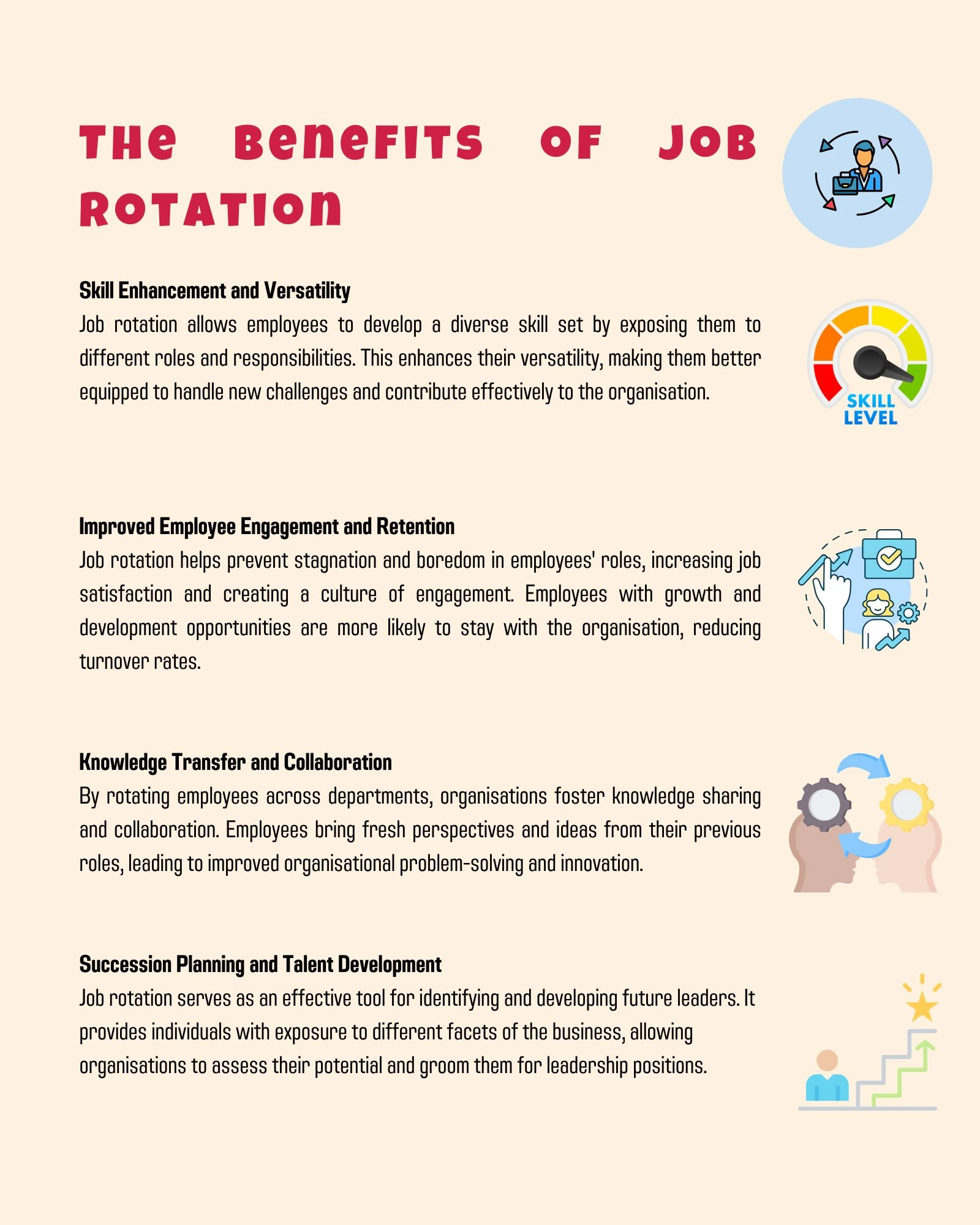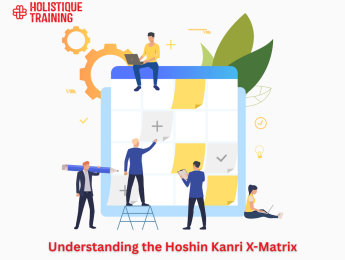- Table of Contents
- Introduction
- What Is Job Rotation?
- Objectives of Job Rotation
- Skill Development
- Talent Retention and Engagement
- Succession Planning
- Table 1: Sample Job Rotation Plan
- Job Rotation Best Practices
- 1- Clear Objectives and Communication
- 2- Structured and Well-Defined Rotations
- 3- Collaboration and Knowledge Sharing
- 4- Support and Training
- 5- Feedback Loops and Continuous Improvement
- 6- Comprehensive Skill Assessments
- 7- Encourage Reverse Job Rotation
- 8- Emphasise Ethical Considerations
- 9- Support Employee Well-being
- 10- Establish a Knowledge Repository
- The Benefits of Job Rotation
- The Data Speaks: Employee Perceptions of Job Rotation
- Disadvantages of Job Rotation
- Disruption of Workflow
- Skill Gaps and Reduced Specialisation
- Increased Training Costs
- Job Rotation in the Era of Remote Work
- 1. Virtual Job Rotation Platforms
- 2. Global Collaboration and Cross-Cultural Exposure
- 3. Mentorship and Virtual Onboarding
- 4. Skill Enhancement through Online Learning
- 5. Flexible Rotational Periods
- 6. Measuring Remote Rotation Success
- 7. Cultivating a Remote Rotation Culture
- Job Rotation and Diversity, Equity, and Inclusion (DEI)
- 1. Enhancing Diversity in Leadership Roles
- 2. Encouraging Cross-Cultural Understanding
- 3. Addressing Unconscious Bias
- 4. Building a Collaborative Workforce
- 5. Creating Inclusive Rotational Opportunities
- 6. Empowering Employee Resource Groups (ERGs)
- 7. Celebrating Diversity in Rotational Experiences
- Conclusion
Introduction
In today's dynamic and competitive work environment, organisations continuously seek innovative ways to develop their employees' skills, improve job satisfaction, and promote knowledge sharing. One such strategy that is gaining popularity is job rotation. Job rotation involves systematically moving employees across different organisational roles and departments. In this blog post, we will delve into the concept of job rotation, its objectives, best practices, and benefits and disadvantages.
What Is Job Rotation?
Job rotation can be defined as the intentional movement of employees across different positions, departments, or projects within an organisation. It aims to expose employees to various aspects of the business, allowing them to acquire new skills, broaden their knowledge, and gain a holistic understanding of the organisation's operations. By rotating employees, organisations enable them to explore different roles and responsibilities, fostering their professional growth and versatility.
Objectives of Job Rotation
Job rotation serves several key objectives that contribute to the overall success of an organisation. These include:
Skill Development
Job rotation facilitates the acquisition of diverse skills and competencies, enabling employees to become more adaptable and versatile in their roles. For example, a software developer who rotates to a project management role gains valuable experience in coordinating teams, managing timelines, and understanding the business side of projects. Exposure to different tasks and responsibilities helps individuals enhance their problem-solving abilities, decision-making skills, and overall job proficiency.
Talent Retention and Engagement
Job rotation helps retain top talent by offering employees the opportunity to explore different roles. It enhances employee engagement and job satisfaction, as individuals feel a sense of challenge, growth, and increased value within the organisation. For instance, a marketing professional who rotates to a sales role can experience new challenges and responsibilities, keeping them motivated and engaged. This, in turn, reduces turnover rates and improves overall employee morale.
Succession Planning
Job rotation plays a crucial role in succession planning by identifying and preparing potential future leaders within the organisation. Through exposure to different business areas, employees develop a broad perspective, which is beneficial when assuming higher-level roles. For example, a junior manager rotating through various departments comprehensively understands the organisation's operations, making them well-suited for higher-level managerial positions.
Rotation | Department | Duration | Learning Objectives |
Rotation 1 | Marketing | 6 months | Develop marketing strategy and campaign management |
Rotation 2 | Sales | 4 months | Sales techniques and customer relationship building |
Rotation 3 | Product | 5 months | Product development and launch |
Rotation 4 | Customer Service | 3 months | Handling customer inquiries and issue resolution |
Table 1: Sample Job Rotation Plan
Job Rotation Best Practices
Implementing job rotation effectively requires careful planning and consideration of various factors. Here are some best practices to ensure a successful job rotation programme:
1- Clear Objectives and Communication
Clearly define the objectives and expectations of the job rotation programme to employees. Communication should be transparent and comprehensive, ensuring employees understand the purpose and benefits of their participation. For example, the organisation can communicate that the programme aims to foster skill development, provide growth opportunities, and enhance overall employee engagement.
2- Structured and Well-Defined Rotations
Develop a structured framework for job rotations, outlining each rotation's duration, responsibilities, and learning objectives. Ensure rotations align with employees' interests, capabilities, and organisational needs. For instance, a six-month rotation in the customer service department can expose employees to customer interactions, complaint resolution, and product knowledge.
3- Collaboration and Knowledge Sharing
Encourage collaboration and knowledge sharing among employees during job rotations. Create opportunities for individuals to connect with colleagues from different departments, fostering cross-functional learning and networking. For example, organising regular team-building activities, knowledge-sharing sessions, or cross-departmental projects can facilitate collaboration and strengthen employee relationships.
4- Support and Training
Provide necessary support and training to employees before and during their rotations. This may involve orientation programmes, mentoring, or access to resources that help individuals succeed in their new roles. For instance, offering a comprehensive onboarding process and assigning mentors to guide employees during their rotations can ensure a smooth transition and maximise their learning experience.
5- Feedback Loops and Continuous Improvement
Establish regular feedback mechanisms to gather insights from employees undergoing job rotations and supervisors. Conduct surveys, focus group discussions, or one-on-one feedback sessions to assess the effectiveness of the rotation experience. Use this feedback to improve continuously, tailoring future rotations based on the collected insights. This iterative approach ensures the programme evolves in alignment with the employees and the organisation's changing needs and expectations.
6- Comprehensive Skill Assessments
Before initiating job rotations, conduct comprehensive skill assessments for participating employees. Identify their existing skill sets, competencies, and areas for development. This assessment forms the foundation for designing challenging rotations that are aligned with the employees' capabilities. Regularly update these assessments to track skill progression, allowing the organisation to measure the impact of job rotations on individual skill development.
7- Encourage Reverse Job Rotation
Incorporate a practice of reverse job rotation where senior or experienced employees spend time in entry-level roles. This initiative fosters empathy, mutual understanding, and collaboration among employees at different career stages. It breaks down hierarchical barriers, promotes cross-generational knowledge transfer, and strengthens the overall cohesion within the workforce.
8- Emphasise Ethical Considerations
During job rotations, employees might gain access to sensitive information or projects in various departments. It is imperative to instil ethical guidelines and confidentiality protocols. Employees should be aware of the ethical considerations associated with the information they handle. Conduct training sessions and awareness programmes to ensure that individuals understand their ethical responsibilities, thereby fostering trust and maintaining the integrity of the rotation programme.
9- Support Employee Well-being
Recognise that job rotations can be mentally and emotionally challenging for employees, especially if they are transitioning to significantly different roles. Provide emotional support through mentorship, coaching, and counselling services. Encourage employees to share their concerns and challenges openly. Additionally, they offer resources such as stress management workshops or employee assistance programmes to support their overall well-being throughout the rotation process.
10- Establish a Knowledge Repository
Create a centralised knowledge repository to document the experiences, learnings, and best practices from past job rotations. This repository is valuable for employees and managers involved in future rotations. It can include case studies, success stories, training materials, and relevant documentation. By consolidating this knowledge, the organisation ensures that the wisdom gained from previous rotations is leveraged effectively, promoting consistent learning and development across the organisation.
The Benefits of Job Rotation
In 1970, merely 4% of CEOs embraced job rotation within their organisations. Fast forward to today, and this figure has surged significantly, with 28% of CEOs now implementing job rotation initiatives, according to The Human Capital Hub. This shows that job rotation offers numerous benefits for both employees and organisations. Let's explore some of these key advantages:

Skill Enhancement and Versatility
Job rotation allows employees to develop a diverse skill set by exposing them to different roles and responsibilities. This enhances their versatility, making them better equipped to handle new challenges and contribute effectively to the organisation. For example, an HR professional who rotates through recruitment, training, and compensation functions gains a comprehensive understanding of HR operations, enabling them to handle various HR-related tasks.
Improved Employee Engagement and Retention
Job rotation helps prevent stagnation and boredom in employees' roles, increasing job satisfaction and creating a culture of engagement. Employees with growth and development opportunities are more likely to stay with the organisation, reducing turnover rates. For instance, a sales representative who rotates to a marketing role can experience new challenges, learn different strategies, and contribute to innovative marketing campaigns, increasing job satisfaction.
Knowledge Transfer and Collaboration
By rotating employees across departments, organisations foster knowledge sharing and collaboration. Employees bring fresh perspectives and ideas from their previous roles, leading to improved organisational problem-solving and innovation. For example, an engineer who rotates to the research and development department can apply their technical expertise to contribute innovative ideas to product development.
Succession Planning and Talent Development
Job rotation serves as an effective tool for identifying and developing future leaders. It provides individuals with exposure to different facets of the business, allowing organisations to assess their potential and groom them for leadership positions. For instance, an aspiring manager who rotates through different departments gains a holistic understanding of the organisation, acquires diverse skills, and develops the necessary leadership qualities.
The Data Speaks: Employee Perceptions of Job Rotation
To further prove the above, a survey was conducted to gauge employee perceptions of job rotation. The survey included responses from employees across various industries and roles. Here are some key findings:
Positive Impact on Employee Value: 92% of the participants believed that job variety contributes to increased employee value within the organisation. This underscores the notion that employees who experience diverse roles are seen as more valuable assets.
Enhanced Attitudes Toward Work: An overwhelming 85.7% of respondents acknowledged that job rotation positively influenced their attitudes towards work and fostered enhanced career development. This reaffirms the link between job rotation and improved employee morale and career satisfaction.
Prospects for Promotion: A substantial 74.1% of the employees indicated that job variety enhances their prospects for promotion, highlighting the correlation between diversified experiences and upward mobility. This aligns with the idea that versatile employees are often considered for higher-level roles.
Greater Rewards: 68.9% of participants believed that job rotation offers greater rewards, indicating the potential for increased recognition and incentives associated with varied roles. This suggests that employees who engage in job rotation are likely to be rewarded for their adaptability and contributions.
Improved Job Safety: 62.4% of respondents recognised that acquiring new skills through job rotation contributes to improved job safety, emphasising the broader benefits of skill diversification in ensuring a secure work environment. This implies that employees with varied skill sets may be better equipped to handle unforeseen challenges, contributing to overall workplace safety.
Disadvantages of Job Rotation
While job rotation offers numerous benefits, there are some potential disadvantages to consider:
Disruption of Workflow
Frequent rotation of employees may lead to disruptions in workflow, especially if individuals are moved to unfamiliar roles or departments. It can take time for employees to adjust and become productive in new positions. To mitigate this, organisations can provide sufficient training and support during transitions and ensure clear communication regarding expectations and timelines.
Skill Gaps and Reduced Specialisation
Job rotation may lead employees to acquire a broad range of skills but lack specialisation in specific areas. This can pose challenges when specialised expertise is required, especially in technical or highly specialised fields. To address this, organisations can combine job rotation with targeted training programmes to ensure employees develop both a breadth of skills and expertise in specific areas.
Increased Training Costs
Regular rotation of employees necessitates investing in training programmes to ensure they are adequately prepared for new roles. This can result in increased training costs for the organisation. Organisations can leverage internal resources and mentorship programmes to manage costs, utilise e-learning platforms, or collaborate with external training providers for cost-effective training solutions.
Pros of Job Rotation | Cons of Job Rotation |
Skill Development | Disruption of Workflow |
Talent Retention and Engagement | Skill Gaps and Reduced Specialisation |
Succession Planning | Increased Traiinnig Costs |
Table 2: Pros and cons of job rotation
Job Rotation in the Era of Remote Work
The advent of remote work has significantly reshaped the job rotation landscape, bringing forth challenges and opportunities. As organisations increasingly embrace telecommuting, job rotation in the remote work era takes on a new dimension, offering unique advantages while requiring innovative approaches to implementation. Let's explore this fascinating intersection between job rotation and remote work:
1. Virtual Job Rotation Platforms
- Online Skill Exchange Platforms: Dedicated platforms can be created within organisations where employees can list their skills and interests. Colleagues can then 'swap' roles virtually, allowing them to gain exposure to different functions.
- Internal Job Marketplaces: Organisations can establish internal marketplaces where job rotation opportunities are posted. Employees can apply for these positions regardless of their location, leading to a seamless and accessible rotation process.
2. Global Collaboration and Cross-Cultural Exposure
- Global Teams: Remote work erases geographical boundaries, enabling organisations to form global teams comprising individuals from diverse cultural backgrounds. Job rotation within such teams enhances skills and fosters cultural understanding, a valuable asset in today's interconnected world.
- Virtual Cross-Departmental Projects: Remote collaboration tools facilitate the creation of cross-departmental projects involving team members from different locations. Participating in these projects allows employees to gain insights into various roles while contributing meaningfully to the organisation's objectives.
3. Mentorship and Virtual Onboarding
- Virtual Mentorship Programmes: Establish mentorship programmes where experienced employees mentor newcomers or those rotating into new roles remotely. Regular virtual meetings and knowledge-sharing sessions can bridge the physical gap, ensuring a smooth transition for employees.
- Interactive Virtual Onboarding: Remote employees undergoing job rotations can benefit from interactive virtual onboarding sessions. These sessions can include immersive experiences, such as virtual office tours and department-specific webinars, providing a comprehensive understanding of the new role and work environment.
4. Skill Enhancement through Online Learning
- E-Learning Modules: Remote work allows employees to use e-learning modules tailored to their new roles. Online courses, webinars, and workshops provide an avenue for skill development, ensuring that employees are well-equipped to excel in their rotated positions.
- Certification Programmes: Organisations can sponsor certification programmes for employees during job rotations. By gaining relevant certifications, employees enhance their skills and add valuable credentials to their professional profiles, benefiting both the individual and the organisation.
5. Flexible Rotational Periods
- Short-Term Virtual Rotations: Remote work facilitates short-term, project-specific rotations. Employees can be temporarily assigned to different departments to work on specific projects, gaining exposure without a long-term commitment.
- Extended Remote Rotations: For roles that require a more extended immersion, employees can work remotely in their rotated positions for an extended period. This arrangement allows for in-depth skill development while maintaining the flexibility and benefits of remote work.
6. Measuring Remote Rotation Success
- Performance Metrics: Key performance indicators (KPIs) can be established for employees undergoing remote job rotations. These metrics can include project completion rates, client satisfaction scores, or individual skill development milestones, providing tangible measures of success.
- Employee Feedback and Surveys: Regular feedback sessions and surveys can be conducted to gauge the satisfaction and effectiveness of remote job rotations. Employee input can guide refinements in the rotational process, ensuring continuous improvement.
7. Cultivating a Remote Rotation Culture
- Leadership Support: Leadership plays a pivotal role in fostering a remote rotation culture. Encouraging managers to support and participate in remote rotations actively sets a positive tone, emphasising the importance of this practice within the organisation.
- Recognition and Rewards: Recognising the achievements of employees who excel during remote rotations is essential. Rewards, both monetary and non-monetary, serve as powerful motivators, encouraging employees to participate in and invest in their rotational experiences actively.
Job Rotation and Diversity, Equity, and Inclusion (DEI)
The intersection of job rotation and Diversity, Equity, and Inclusion (DEI) initiatives represents a significant opportunity for organisations to create a workplace that celebrates differences, promotes equal opportunities, and nurtures innovation through diverse perspectives.
1. Enhancing Diversity in Leadership Roles
Job rotation can be a pivotal strategy in breaking down barriers for underrepresented groups within an organisation. By systematically rotating employees through various departments and roles, organisations can identify diverse talents and groom them for leadership positions. This proactive approach ensures that individuals from all backgrounds have equal access to high-profile roles, promoting diversity at the top tiers of the organisational hierarchy.
2. Encouraging Cross-Cultural Understanding
In diverse work environments, job rotation fosters cross-cultural understanding by exposing employees to different cultures, perspectives, and work styles. When individuals from varied backgrounds rotate through different roles, they bring unique viewpoints to each department. This enriches team dynamics and encourages the appreciation of diverse ideas, promoting an inclusivity culture where employees respect and learn from one another.
3. Addressing Unconscious Bias
Job rotation can be a powerful tool to address unconscious biases within the workplace. When employees rotate through roles based on their skills and potential rather than stereotypes, it challenges preconceived notions. Exposure to diverse talents in various positions helps dismantle biases, encourage fair evaluation, and promote an inclusive environment where decisions are made on merit and skills.
4. Building a Collaborative Workforce
Rotating employees through different roles and departments creates a collaborative workforce where individuals from diverse backgrounds learn to work together effectively. Building teams with individuals from varied rotations enhance teamwork, creativity, and problem-solving abilities. Collaboration among employees with different experiences and perspectives often leads to innovative solutions, driving the organisation forward.
5. Creating Inclusive Rotational Opportunities
Organisations can proactively design job rotation programmes that are accessible and inclusive. This includes considering the specific needs of employees with disabilities, accommodating various work styles, and offering support for employees from different cultural backgrounds. By tailoring the rotation experience to individual needs, organisations can ensure everyone has an equal opportunity to participate and benefit from job rotation initiatives.
6. Empowering Employee Resource Groups (ERGs)
Employee Resource Groups, representing various demographics within the organisation, can play a vital role in shaping inclusive job rotation programmes. These groups can provide insights into different communities' unique challenges and help design rotations that cater to specific needs. Empowering ERGs to participate in the planning and execution of job rotations actively ensures that the initiatives are aligned with the organisation’s DEI goals.
7. Celebrating Diversity in Rotational Experiences
Organisations can celebrate employees' diverse backgrounds and experiences by participating in job rotations. Highlighting success stories of individuals from underrepresented groups who have excelled during rotations inspires and showcases the organisation’s commitment to diversity and inclusion. Celebratory events, newsletters, or internal communications can spotlight these achievements, reinforcing the value of diverse perspectives.
Incorporating job rotation within the framework of Diversity, Equity, and Inclusion initiatives goes beyond mere employee development; it becomes a catalyst for cultural transformation. By embracing diversity through intentional job rotations, organisations create a workplace where every employee feels valued, empowered, and inspired to contribute their best, fostering an environment of innovation, collaboration, and mutual respect.
Conclusion
When implemented thoughtfully, job rotation can be a powerful tool for enhancing employee development, engagement, and organisational effectiveness. Organisations can create a dynamic and adaptable workforce by providing employees with opportunities to expand their skills, knowledge, and perspectives. However, it is crucial to consider each organisation's specific context and challenges when implementing job rotation. Balancing the benefits and disadvantages ensures that job rotation is tailored to meet the unique needs and goals of both employees and the organisation as a whole.
Remember, job rotation should be an intentional and strategic initiative that aligns with the organisation's overall talent management and development strategy. By embracing job rotation, organisations can foster a culture of continuous learning, innovation, and growth, ultimately contributing to their long-term success.
















